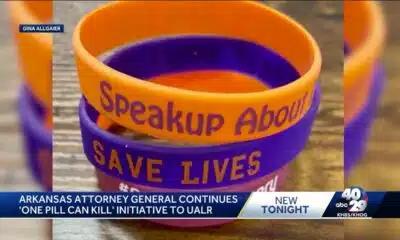Kaiser Health News
Did a Military Lab Spill Anthrax Into Public Waterways? New Book Reveals Details of a US Leak
by Alison Young
Tue, 25 Apr 2023 09:00:00 +0000
[Editor’s note: In 2019, federal lab regulators ordered the prestigious U.S. Army Medical Research Institute of Infectious Diseases to halt all work with dangerous pathogens, such as Ebola and anthrax, which can pose a severe threat to public health and safety.
Army officials had assured the public there was no safety threat and indicated that no pathogens had leaked outside the laboratory after flooding in 2018. But in a new book released April 25, investigative reporter Alison Young reveals there were repeated and egregious safety breaches and government oversight failures at Fort Detrick, Maryland, that preceded the 2019 shutdown. This article is adapted from “Pandora’s Gamble: Lab Leaks, Pandemics, and a World at Risk.”]
Unsterilized laboratory wastewater from the U.S. Army Medical Research Institute of Infectious Diseases at Fort Detrick, Maryland, spewed out the top of a rusty 50,000-gallon outdoor holding tank, the pressure catapulting it over the short concrete wall that was supposed to contain hazardous spills.
It was May 25, 2018, the Friday morning before Memorial Day weekend, and the tank holding waste from labs working with Ebola, anthrax, and other lethal pathogens had become overpressurized, forcing the liquid out a vent pipe.
An estimated 2,000-3,000 gallons streamed into a grassy area a few feet from an open storm drain that dumps into Carroll Creek — a centerpiece of downtown Frederick, Maryland, a city of about 80,000 an hour’s drive from the nation’s capital.
But as the waste sprayed for as long as three hours, records show, none of the plant’s workers apparently noticed the tank had burst a pipe. This was despite the facility being under scrutiny from federal lab regulators following catastrophic flooding and an escalating series of safety failures that had been playing out for more than a week.
***
Before the outdoor tank failed, there had already been breaches of other lab waste storage tanks inside the sterilization plant.
On May 17, 2018, in the wake of devastating storms, workers at Fort Detrick discovered that the plant’s basement was filling with water that would reach 4 to 5 feet deep. Some of it was rainwater seeping in from outdoors. But a lot was fluid leaking from the basement’s long-deteriorating tanks that held thousands of gallons of unsterilized lab wastewater.
As basement sump pumps forced floodwater into these tanks, the influx disgorged lab waste through cracks along the tops of the tanks, sending it streaming back toward the floor.
The steam sterilization plant, referred to as “the SSP,” was built in 1953. It was designed to essentially cook the wastewater that flowed into it from Fort Detrick’s biological laboratories, ensuring that all deadly pathogens were killed before the water was released from the base into the Monocacy River.
USAMRIID’s safety protocols called for a two-step kill process for lab wastewater. Before it was sent down drains into Fort Detrick’s dedicated laboratory sewer system for heat treatment at the plant, lab workers were supposed to pretreat potentially infectious liquids with bleach or other chemicals.
But chemical disinfection can be tricky. To be effective, it requires workers to use the right kind of disinfectant at the right concentration and, importantly, to ensure that the disinfectant remains in contact with the microbes long enough to kill them.
Any living organisms left behind could multiply.
Despite the plant’s importance to protecting public health, by May 2018 it had become a rusting, leaking, temperamental hulk.
It was 65 years old and was supposed to have been torn down already. But a replacement plant completed at a cost to taxpayers of more than $30 million had suffered a “catastrophic failure” in 2016 and couldn’t be repaired, records show.
So even though the sterilization plant was in significant disrepair, USAMRIID still used it, with a much smaller amount of waste coming from a U.S. Department of Agriculture lab that worked with weeds and plant diseases.
On a typical day in 2018, state records show, these facilities sent about 30,000 gallons of laboratory wastewater into the plant, which had five 50,000-gallon storage tanks in its basement, plus an additional nine interconnected 50,000-gallon storage tanks outside.
Fort Detrick officials had been aware for some time that the tops of the aging basement storage tanks had multiple leaks caused over the years by chlorine gases accumulating on the surface of the wastewater, according to a state investigation report of the incident and the Army garrison’s responses to questions.
It was so much of an issue that the garrison’s Directorate of Public Works employees, who operated the plant, had to make sure the tanks didn’t ever fill up completely or else the potentially infectious water would spill out.
Their workaround was to try to limit the amount of waste in each basement tank to about half capacity. But the flooding in May 2018 made that impossible because the sump pumps were sending so much water into the sterilization system.
Lab inspectors from the Centers for Disease Control and Prevention had apparently failed to recognize the plant was in such disrepair. The CDC offered no explanation of how the problems were missed, but after the incident it created a new policy and task force for overseeing labs’ wastewater decontamination systems.
Samuel Edwin, director of the CDC’s select agent regulatory program, did not grant an interview. Two years before the plant flooded and failed, the CDC had hired Edwin from USAMRIID, where he had spent eight years as the biological surety officer and responsible official in charge of making sure USAMRIID’s labs complied with federal regulations.
Edwin, in an emailed statement, said he wasn’t aware of any corrosion or leak issues while he worked at USAMRIID.
Federal Select Agent Program regulators from the CDC inspected the plant annually, Edwin said, adding: “FSAP did not observe, and I did not report, any issues with the SSP during this time.”
Four days after the plant flooded, CDC inspectors arrived at Fort Detrick and spent May 21 and 22, 2018, inspecting the facility. As the CDC inspectors left Fort Detrick, they allowed USAMRIID to resume some research activities.
The long Memorial Day weekend was coming up, and the weather forecast showed more rain headed toward Frederick. To protect the plant against further flooding, a decision was made to pump the water inside the basement’s waste storage tanks into the auxiliary tanks outdoors. The hope was to free up an additional 80,000 gallons of capacity, Fort Detrick said in response to questions.
Things didn’t go as planned.
Somewhere along the way, an automatic shut-off feature designed to keep the outdoor tanks from overfilling was deactivated, Fort Detrick officials later said in response to questions.
***
It was an employee of the National Cancer Institute, which has a research building at Fort Detrick near the plant, who spotted wastewater spewing from an outdoor wastewater tank, over the containment wall, and into a grassy area with an open storm drain inlet that sends runoff into Carroll Creek, according to records and Fort Detrick’s responses to questions. The person called it in to the “trouble desk” of the garrison’s Directorate of Public Works on that Friday morning, May 25.
But nobody checked on the tank until noon, Fort Detrick said. The dispatched workers reported back that they didn’t see any leaking fluid. They checked the tanks again at 2 p.m. and still saw nothing. So nothing was done.
If not for the persistence of the unidentified National Cancer Institute employee, the leak would have been ignored.
On the Wednesday after the holiday, that person contacted the Fort Detrick safety manager. They wanted to follow up on their previous report — and this time they provided photos proving the tank had been spraying wastewater nearly a week earlier.
The photos got the base’s attention.
The Fort Detrick Command was immediately notified. So was USAMRIID’s leadership.
But another day passed before anyone alerted state and local authorities.
***
A significant question remained: What was in the lab wastewater that spewed out of the tank?
If viable organisms like anthrax bacteria had been sent into public waterways, the consequences could be disastrous for USAMRIID, Fort Detrick — and the CDC regulators who allowed them to keep operating despite the jury-rigged sterilization plant.
The risk that people or animals would become infected was probably low, with any organisms likely reduced below infectious levels as the waste became diluted by the floodwaters still surging through the area’s streams and rivers. But public backlash and headlines were certainties.
So, what was in the wastewater?
Nobody seemed to be looking very hard to find out.
USAMRIID and Fort Detrick officials offered only generalized assurances that their tests hadn’t detected any pathogens. But they would not release copies of testing reports.
Rather than serve as watchdogs in the public interest, all levels of government seemed to largely defer to USAMRIID and its expertise — despite the organization’s egregious safety breach and potential self-interest in damage control.
In the weeks before the tank started spewing wastewater, USAMRIID had been experimenting with 16 organisms, and lab officials said they had tested the concrete pad and the ground adjacent to the tanks and hadn’t detected any of them. Anthrax was the organism of greatest concern because of its ability to persist in the environment, something many pathogens can’t do for very long.
Other organisms that were possibly in the wastewater were Ebola virus, Lassa fever virus, Junín virus, Marburg virus, Venezuelan equine encephalitis virus, eastern equine encephalitis virus, Crimean-Congo hemorrhagic fever virus, Nipah virus, Burkholderia pseudomallei, Burkholderia mallei, Francisella tularensis, western equine encephalitis virus, Dobrava-Belgrade virus, Seoul virus, and Chikungunya virus.
But all test results were negative, USAMRIID officials said.
How meaningful was USAMRIID’s testing?
USAMRIID and Fort Detrick officials didn’t do any environmental tests until May 31 and June 1 — about a week after the tank overflowed. By then, it had rained, which, in response to questions, USAMRIID acknowledged would have had a “dilutional effect” if any pathogens had been present.
Did USAMRIID test two samples or 20 samples or 200 samples? What were the detection limits of the testing methods used? How might the rain — or wind or sunlight — have affected the ability of the tests to detect organisms a week after their release?
USAMRIID and Fort Detrick officials would not release copies of the testing reports. For months, they wouldn’t even say how many samples were tested.
“The test plan was reviewed and approved by the CDC,” USAMRIID said in a written statement.
CDC lab regulators said USAMRIID developed and conducted its own testing.
“USAMRIID test results indicated the public health risk associated with any potential release was negligible; however, you would need to contact USAMRIID for full information about the testing methods and results,” the CDC said.
Eventually, after months of requests, USAMRIID said its testing to determine whether pathogens had escaped involved just five swab samples collected from “various locations” at the plant.
As further evidence that no deadly microbes had escaped, records show that Army officials noted to state and local officials — without providing reports or details — that they had done additional validation testing inside USAMRIID’s laboratories that showed lab drains contained sufficient disinfectant to kill anything poured down them. The implication was that there was no risk from the plant’s unsterilized wastewater and that the heat-treating process was nice, but not necessary.
Documents obtained under the Freedom of Information Act revealed that these drain tests weren’t performed under real-life conditions. Instead, the Army acknowledged, they were done in empty labs where no work had been occurring and no animals were present.
Of perhaps greater concern: The drain tests were performed solely in response to the regulatory and public relations crisis from the lab leak in May 2018. It was the only time — from January 2015 through at least March 2022 — that USAMRIID had checked the adequacy of the disinfectant in its drains, the Army’s FOIA response said.
Excerpted from “Pandora’s Gamble” by Alison Young (Copyright 2023). Used with permission from Center Street, a division of Hachette Book Group Inc.
Alison Young is an investigative reporter in Washington, D.C., and serves as the Curtis B. Hurley Chair in Public Affairs Reporting for the University of Missouri School of Journalism. During 2009-19, she was a reporter and member of USA Today’s national investigative team. She has reported on laboratory accidents for 15 years for news organizations that include USA Today, The Atlanta Journal-Constitution, and ProPublica.
By: Alison Young
Title: Did a Military Lab Spill Anthrax Into Public Waterways? New Book Reveals Details of a US Leak
Sourced From: kffhealthnews.org/news/article/lab-leak-biohazard-wastewater-book-excerpt-pandoras-gamble-alison-young/
Published Date: Tue, 25 Apr 2023 09:00:00 +0000
Kaiser Health News
How To Find the Right Medical Rehab Services
Rehabilitation therapy can be a godsend after hospitalization for a stroke, a fall, an accident, a joint replacement, a severe burn, or a spinal cord injury, among other conditions. Physical, occupational, and speech therapy are offered in a variety of settings, including at hospitals, nursing homes, clinics, and at home. It’s crucial to identify a high-quality, safe option with professionals experienced in treating your condition.
What kinds of rehab therapy might I need?
Physical therapy helps patients improve their strength, stability, and movement and reduce pain, usually through targeted exercises. Some physical therapists specialize in neurological, cardiovascular, or orthopedic issues. There are also geriatric and pediatric specialists. Occupational therapy focuses on specific activities (referred to as “occupations”), often ones that require fine motor skills, like brushing teeth, cutting food with a knife, and getting dressed. Speech and language therapy help people communicate. Some patients may need respiratory therapy if they have trouble breathing or need to be weaned from a ventilator.
Will insurance cover rehab?
Medicare, health insurers, workers’ compensation, and Medicaid plans in some states cover rehab therapy, but plans may refuse to pay for certain settings and may limit the amount of therapy you receive. Some insurers may require preauthorization, and some may terminate coverage if you’re not improving. Private insurers often place annual limits on outpatient therapy. Traditional Medicare is generally the least restrictive, while private Medicare Advantage plans may monitor progress closely and limit where patients can obtain therapy.
Should I seek inpatient rehabilitation?
Patients who still need nursing or a doctor’s care but can tolerate three hours of therapy five days a week may qualify for admission to a specialized rehab hospital or to a unit within a general hospital. Patients usually need at least two of the main types of rehab therapy: physical, occupational, or speech. Stays average around 12 days.
How do I choose?
Look for a place that is skilled in treating people with your diagnosis; many inpatient hospitals list specialties on their websites. People with complex or severe medical conditions may want a rehab hospital connected to an academic medical center at the vanguard of new treatments, even if it’s a plane ride away.
“You’ll see youngish patients with these life-changing, fairly catastrophic injuries,” like spinal cord damage, travel to another state for treatment, said Cheri Blauwet, chief medical officer of Spaulding Rehabilitation in Boston, one of 15 hospitals the federal government has praised for cutting-edge work.
But there are advantages in selecting a hospital close to family and friends who can help after you are discharged. Therapists can help train at-home caregivers.
How do I find rehab hospitals?
The discharge planner or caseworker at the acute care hospital should provide options. You can search for inpatient rehabilitation facilities by location or name through Medicare’s Care Compare website. There you can see how many patients the rehab hospital has treated with your condition — the more the better. You can search by specialty through the American Medical Rehabilitation Providers Association, a trade group that lists its members.
Find out what specialized technologies a hospital has, like driving simulators — a car or truck that enable a patient to practice getting in and out of a vehicle — or a kitchen table with utensils to practice making a meal.
How can I be confident a rehab hospital is reliable?
It’s not easy: Medicare doesn’t analyze staffing levels or post on its website results of safety inspections as it does for nursing homes. You can ask your state public health agency or the hospital to provide inspection reports for the last three years. Such reports can be technical, but you should get the gist. If the report says an “immediate jeopardy” was called, that means inspectors identified safety problems that put patients in danger.
The rate of patients readmitted to a general hospital for a potentially preventable reason is a key safety measure. Overall, for-profit rehabs have higher readmission rates than nonprofits do, but there are some with lower readmission rates and some with higher ones. You may not have a nearby choice: There are fewer than 400 rehab hospitals, and most general hospitals don’t have a rehab unit.
You can find a hospital’s readmission rates under Care Compare’s quality section. Rates lower than the national average are better.
Another measure of quality is how often patients are functional enough to go home after finishing rehab rather than to a nursing home, hospital, or health care institution. That measure is called “discharge to community” and is listed under Care Compare’s quality section. Rates higher than the national average are better.
Look for reviews of the hospital on Yelp and other sites. Ask if the patient will see the same therapist most days or a rotating cast of characters. Ask if the therapists have board certifications earned after intensive training to treat a patient’s particular condition.
Visit if possible, and don’t look only at the rooms in the hospital where therapy exercises take place. Injuries often occur in the 21 hours when a patient is not in therapy, but in his or her room or another part of the building. Infections, falls, bedsores, and medication errors are risks. If possible, observe whether nurses promptly respond to call lights, seem overloaded with too many patients, or are apathetically playing on their phones. Ask current patients and their family members if they are satisfied with the care.
What if I can’t handle three hours of therapy a day?
A nursing home that provides rehab might be appropriate for patients who don’t need the supervision of a doctor but aren’t ready to go home. The facilities generally provide round-the-clock nursing care. The amount of rehab varies based on the patient. There are more than 14,500 skilled nursing facilities in the United States, 12 times as many as hospitals offering rehab, so a nursing home may be the only option near you.
You can look for them through Medicare’s Care Compare website. (Read our previous guide to finding a good, well-staffed home to know how to assess the overall staffing.)
What if patients are too frail even for a nursing home?
They might need a long-term care hospital. Those specialize in patients who are in comas, on ventilators, and have acute medical conditions that require the presence of a physician. Patients stay at least four weeks, and some are there for months. Care Compare helps you search. There are fewer than 350 such hospitals.
I’m strong enough to go home. How do I receive therapy?
Many rehab hospitals offer outpatient therapy. You also can go to a clinic, or a therapist can come to you. You can hire a home health agency or find a therapist who takes your insurance and makes house calls. Your doctor or hospital may give you referrals. On Care Compare, home health agencies list whether they offer physical, occupational, or speech therapy. You can search for board-certified therapists on the American Physical Therapy Association’s website.
While undergoing rehab, patients sometimes move from hospital to nursing facility to home, often at the insistence of their insurers. Alice Bell, a senior specialist at the APTA, said patients should try to limit the number of transitions, for their own safety.
“Every time a patient moves from one setting to another,” she said, “they’re in a higher risk zone.”
KFF Health News is a national newsroom that produces in-depth journalism about health issues and is one of the core operating programs at KFF—an independent source of health policy research, polling, and journalism. Learn more about KFF.
USE OUR CONTENT
This story can be republished for free (details).
KFF Health News is a national newsroom that produces in-depth journalism about health issues and is one of the core operating programs at KFF—an independent source of health policy research, polling, and journalism. Learn more about KFF.
Subscribe to KFF Health News’ free Morning Briefing.
This article first appeared on KFF Health News and is republished here under a Creative Commons license.
The post How To Find the Right Medical Rehab Services appeared first on kffhealthnews.org
Note: The following A.I. based commentary is not part of the original article, reproduced above, but is offered in the hopes that it will promote greater media literacy and critical thinking, by making any potential bias more visible to the reader –Staff Editor.
Political Bias Rating: Centrist
This article from KFF Health News provides a comprehensive, fact-based guide to rehabilitation therapy options and how to navigate insurance, care settings, and provider quality. It avoids ideological framing and presents information in a neutral, practical tone aimed at helping consumers make informed medical decisions. While it touches on Medicare and private insurance policies, it does so without political commentary or value judgments, and no partisan viewpoints or advocacy positions are evident. The focus remains on patient care, safety, and informed choice, supporting a nonpartisan, service-oriented approach to health reporting.
Kaiser Health News
States Brace for Reversal of Obamacare Coverage Gains Under Trump’s Budget Bill
Shorter enrollment periods. More paperwork. Higher premiums. The sweeping tax and spending bill pushed by President Donald Trump includes provisions that would not only reshape people’s experience with the Affordable Care Act but, according to some policy analysts, also sharply undermine the gains in health insurance coverage associated with it.
The moves affect consumers and have particular resonance for the 19 states (plus Washington, D.C.) that run their own ACA exchanges.
Many of those states fear that the additional red tape — especially requirements that would end automatic reenrollment — would have an outsize impact on their policyholders. That’s because a greater percentage of people in those states use those rollovers versus shopping around each year, which is more commonly done by people in states that use the federal healthcare.gov marketplace.
“The federal marketplace always had a message of, ‘Come back in and shop,’ while the state-based markets, on average, have a message of, ‘Hey, here’s what you’re going to have next year, here’s what it will cost; if you like it, you don’t have to do anything,’” said Ellen Montz, who oversaw the federal ACA marketplace under the Biden administration as deputy administrator and director at the Center for Consumer Information and Insurance Oversight. She is now a managing director with the Manatt Health consulting group.
Millions — perhaps up to half of enrollees in some states — may lose or drop coverage as a result of that and other changes in the legislation combined with a new rule from the Trump administration and the likely expiration at year’s end of enhanced premium subsidies put in place during the covid-19 pandemic. Without an extension of those subsidies, which have been an important driver of Obamacare enrollment in recent years, premiums are expected to rise 75% on average next year. That’s starting to happen already, based on some early state rate requests for next year, which are hitting double digits.
“We estimate a minimum 30% enrollment loss, and, in the worst-case scenario, a 50% loss,” said Devon Trolley, executive director of Pennie, the ACA marketplace in Pennsylvania, which had 496,661 enrollees this year, a record.
Drops of that magnitude nationally, coupled with the expected loss of Medicaid coverage for millions more people under the legislation Trump calls the “One Big Beautiful Bill,” could undo inroads made in the nation’s uninsured rate, which dropped by about half from the time most of the ACA’s provisions went into effect in 2014, when it hovered around 14% to 15% of the population, to just over 8%, according to the most recent data.
Premiums would rise along with the uninsured rate, because older or sicker policyholders are more likely to try to jump enrollment hurdles, while those who rarely use coverage — and are thus less expensive — would not.
After a dramatic all-night session, House Republicans passed the bill, meeting the president’s July 4 deadline. Trump is expected to sign the measure on Independence Day. It would increase the federal deficit by trillions of dollars and cut spending on a variety of programs, including Medicaid and nutrition assistance, to partly offset the cost of extending tax cuts put in place during the first Trump administration.
The administration and its supporters say the GOP-backed changes to the ACA are needed to combat fraud. Democrats and ACA supporters see this effort as the latest in a long history of Republican efforts to weaken or repeal Obamacare. Among other things, the legislation would end several changes put in place by the Biden administration that were credited with making it easier to sign up, such as lengthening the annual open enrollment period and launching a special program for very low-income people that essentially allows them to sign up year-round.
In addition, automatic reenrollment, used by more than 10 million people for 2025 ACA coverage, would end in the 2028 sign-up season. Instead, consumers would have to update their information, starting in August each year, before the close of open enrollment, which would end Dec. 15, a month earlier than currently.
That’s a key change to combat rising enrollment fraud, said Brian Blase, president of the conservative Paragon Health Institute, because it gets at what he calls the Biden era’s “lax verification requirements.”
He blames automatic reenrollment, coupled with the availability of zero-premium plans for people with lower incomes that qualify them for large subsidies, for a sharp uptick in complaints from insurers, consumers, and brokers about fraudulent enrollments in 2023 and 2024. Those complaints centered on consumers’ being enrolled in an ACA plan, or switched from one to another, without authorization, often by commission-seeking brokers.
In testimony to Congress on June 25, Blase wrote that “this simple step will close a massive loophole and significantly reduce improper enrollment and spending.”
States that run their own marketplaces, however, saw few, if any, such problems, which were confined mainly to the 31 states using the federal healthcare.gov.
The state-run marketplaces credit their additional security measures and tighter control over broker access than healthcare.gov for the relative lack of problems.
“If you look at California and the other states that have expanded their Medicaid programs, you don’t see that kind of fraud problem,” said Jessica Altman, executive director of Covered California, the state’s Obamacare marketplace. “I don’t have a single case of a consumer calling Covered California saying, ‘I was enrolled without consent.’”
Such rollovers are common with other forms of health insurance, such as job-based coverage.
“By requiring everyone to come back in and provide additional information, and the fact that they can’t get a tax credit until they take this step, it is essentially making marketplace coverage the most difficult coverage to enroll in,” said Trolley at Pennie, 65% of whose policyholders were automatically reenrolled this year, according to KFF data. KFF is a health information nonprofit that includes KFF Health News.
Federal data shows about 22% of federal sign-ups in 2024 were automatic-reenrollments, versus 58% in state-based plans. Besides Pennsylvania, the states that saw such sign-ups for more than 60% of enrollees include California, New York, Georgia, New Jersey, and Virginia, according to KFF.
States do check income and other eligibility information for all enrollees — including those being automatically renewed, those signing up for the first time, and those enrolling outside the normal open enrollment period because they’ve experienced a loss of coverage or other life event or meet the rules for the low-income enrollment period.
“We have access to many data sources on the back end that we ping, to make sure nothing has changed. Most people sail through and are able to stay covered without taking any proactive step,” Altman said.
If flagged for mismatched data, applicants are asked for additional information. Under current law, “we have 90 days for them to have a tax credit while they submit paperwork,” Altman said.
That would change under the tax and spending plan before Congress, ending presumptive eligibility while a person submits the information.
A white paper written for Capital Policy Analytics, a Washington-based consultancy that specializes in economic analysis, concluded there appears to be little upside to the changes.
While “tighter verification can curb improper enrollments,” the additional paperwork, along with the expiration of higher premiums from the enhanced tax subsidies, “would push four to six million eligible people out of Marketplace plans, trading limited fraud savings for a surge in uninsurance,” wrote free market economists Ike Brannon and Anthony LoSasso.
“Insurers would be left with a smaller, sicker risk pool and heightened pricing uncertainty, making further premium increases and selective market exits [by insurers] likely,” they wrote.
KFF Health News is a national newsroom that produces in-depth journalism about health issues and is one of the core operating programs at KFF—an independent source of health policy research, polling, and journalism. Learn more about KFF.
USE OUR CONTENT
This story can be republished for free (details).
KFF Health News is a national newsroom that produces in-depth journalism about health issues and is one of the core operating programs at KFF—an independent source of health policy research, polling, and journalism. Learn more about KFF.
Subscribe to KFF Health News’ free Morning Briefing.
This article first appeared on KFF Health News and is republished here under a Creative Commons license.
The post States Brace for Reversal of Obamacare Coverage Gains Under Trump’s Budget Bill appeared first on kffhealthnews.org
Note: The following A.I. based commentary is not part of the original article, reproduced above, but is offered in the hopes that it will promote greater media literacy and critical thinking, by making any potential bias more visible to the reader –Staff Editor.
Political Bias Rating: Center-Left
This content presents a critique of Republican-led changes to the Affordable Care Act, emphasizing potential negative impacts such as increased premiums, reduced enrollment, and the erosion of coverage gains made under the ACA. It highlights the perspective of policy analysts and state officials who express concern over these measures, while also presenting conservative viewpoints, particularly those focusing on fraud reduction. Overall, the tone and framing lean toward protecting the ACA and its expansions, which traditionally aligns with Center-Left media analysis.
Kaiser Health News
Dual Threats From Trump and GOP Imperil Nursing Homes and Their Foreign-Born Workers
In a top-rated nursing home in Alexandria, Virginia, the Rev. Donald Goodness is cared for by nurses and aides from various parts of Africa. One of them, Jackline Conteh, a naturalized citizen and nurse assistant from Sierra Leone, bathes and helps dress him most days and vigilantly intercepts any meal headed his way that contains gluten, as Goodness has celiac disease.
“We are full of people who come from other countries,” Goodness, 92, said about Goodwin House Alexandria’s staff. Without them, the retired Episcopal priest said, “I would be, and my building would be, desolate.”
The long-term health care industry is facing a double whammy from President Donald Trump’s crackdown on immigrants and the GOP’s proposals to reduce Medicaid spending. The industry is highly dependent on foreign workers: More than 800,000 immigrants and naturalized citizens comprise 28% of direct care employees at home care agencies, nursing homes, assisted living facilities, and other long-term care companies.
But in January, the Trump administration rescinded former President Joe Biden’s 2021 policy that protected health care facilities from Immigration and Customs Enforcement raids. The administration’s broad immigration crackdown threatens to drastically reduce the number of current and future workers for the industry. “People may be here on a green card, and they are afraid ICE is going to show up,” said Katie Smith Sloan, president of LeadingAge, an association of nonprofits that care for older adults.
Existing staffing shortages and quality-of-care problems would be compounded by other policies pushed by Trump and the Republican-led Congress, according to nursing home officials, resident advocates, and academic experts. Federal spending cuts under negotiation may strip nursing homes of some of their largest revenue sources by limiting ways states leverage Medicaid money and making it harder for new nursing home residents to retroactively qualify for Medicaid. Care for 6 in 10 residents is paid for by Medicaid, the state-federal health program for poor or disabled Americans.
“We are facing the collision of two policies here that could further erode staffing in nursing homes and present health outcome challenges,” said Eric Roberts, an associate professor of internal medicine at the University of Pennsylvania.
The industry hasn’t recovered from covid-19, which killed more than 200,000 long-term care facility residents and workers and led to massive staff attrition and turnover. Nursing homes have struggled to replace licensed nurses, who can find better-paying jobs at hospitals and doctors’ offices, as well as nursing assistants, who can earn more working at big-box stores or fast-food joints. Quality issues that preceded the pandemic have expanded: The percentage of nursing homes that federal health inspectors cited for putting residents in jeopardy of immediate harm or death has risen alarmingly from 17% in 2015 to 28% in 2024.
In addition to seeking to reduce Medicaid spending, congressional Republicans have proposed shelving the biggest nursing home reform in decades: a Biden-era rule mandating minimum staffing levels that would require most of the nation’s nearly 15,000 nursing homes to hire more workers.
The long-term care industry expects demand for direct care workers to burgeon with an influx of aging baby boomers needing professional care. The Census Bureau has projected the number of people 65 and older would grow from 63 million this year to 82 million in 2050.
In an email, Vianca Rodriguez Feliciano, a spokesperson for the Department of Health and Human Services, said the agency “is committed to supporting a strong, stable long-term care workforce” and “continues to work with states and providers to ensure quality care for older adults and individuals with disabilities.” In a separate email, Tricia McLaughlin, a Department of Homeland Security spokesperson, said foreigners wanting to work as caregivers “need to do that by coming here the legal way” but did not address the effect on the long-term care workforce of deportations of classes of authorized immigrants.
Goodwin Living, a faith-based nonprofit, runs three retirement communities in northern Virginia for people who live independently, need a little assistance each day, have memory issues, or require the availability of around-the-clock nurses. It also operates a retirement community in Washington, D.C. Medicare rates Goodwin House Alexandria as one of the best-staffed nursing homes in the country. Forty percent of the organization’s 1,450 employees are foreign-born and are either seeking citizenship or are already naturalized, according to Lindsay Hutter, a Goodwin spokesperson.
“As an employer, we see they stay on with us, they have longer tenure, they are more committed to the organization,” said Rob Liebreich, Goodwin’s president and CEO.
Jackline Conteh spent much of her youth shuttling between Sierra Leone, Liberia, and Ghana to avoid wars and tribal conflicts. Her mother was killed by a stray bullet in her home country of Liberia, Conteh said. “She was sitting outside,” Conteh, 56, recalled in an interview.
Conteh was working as a nurse in a hospital in Sierra Leone in 2009 when she learned of a lottery for visas to come to the United States. She won, though she couldn’t afford to bring her husband and two children along at the time. After she got a nursing assistant certification, Goodwin hired her in 2012.
Conteh said taking care of elders is embedded in the culture of African families. When she was 9, she helped feed and dress her grandmother, a job that rotated among her and her sisters. She washed her father when he was dying of prostate cancer. Her husband joined her in the United States in 2017; she cares for him because he has heart failure.
“Nearly every one of us from Africa, we know how to care for older adults,” she said.
Her daughter is now in the United States, while her son is still in Africa. Conteh said she sends money to him, her mother-in-law, and one of her sisters.
In the nursing home where Goodness and 89 other residents live, Conteh helps with daily tasks like dressing and eating, checks residents’ skin for signs of swelling or sores, and tries to help them avoid falling or getting disoriented. Of 102 employees in the building, broken up into eight residential wings called “small houses” and a wing for memory care, at least 72 were born abroad, Hutter said.
Donald Goodness grew up in Rochester, New York, and spent 25 years as rector of The Church of the Ascension in New York City, retiring in 1997. He and his late wife moved to Alexandria to be closer to their daughter, and in 2011 they moved into independent living at the Goodwin House. In 2023 he moved into one of the skilled nursing small houses, where Conteh started caring for him.
“I have a bad leg and I can’t stand on it very much, or I’d fall over,” he said. “She’s in there at 7:30 in the morning, and she helps me bathe.” Goodness said Conteh is exacting about cleanliness and will tell the housekeepers if his room is not kept properly.
Conteh said Goodness was withdrawn when he first arrived. “He don’t want to come out, he want to eat in his room,” she said. “He don’t want to be with the other people in the dining room, so I start making friends with him.”
She showed him a photo of Sierra Leone on her phone and told him of the weather there. He told her about his work at the church and how his wife did laundry for the choir. The breakthrough, she said, came one day when he agreed to lunch with her in the dining room. Long out of his shell, Goodness now sits on the community’s resident council and enjoys distributing the mail to other residents on his floor.
“The people that work in my building become so important to us,” Goodness said.
While Trump’s 2024 election campaign focused on foreigners here without authorization, his administration has broadened to target those legally here, including refugees who fled countries beset by wars or natural disasters. This month, the Department of Homeland Security revoked the work permits for migrants and refugees from Cuba, Haiti, Nicaragua, and Venezuela who arrived under a Biden-era program.
“I’ve just spent my morning firing good, honest people because the federal government told us that we had to,” Rachel Blumberg, president of the Toby & Leon Cooperman Sinai Residences of Boca Raton, a Florida retirement community, said in a video posted on LinkedIn. “I am so sick of people saying that we are deporting people because they are criminals. Let me tell you, they are not all criminals.”
At Goodwin House, Conteh is fearful for her fellow immigrants. Foreign workers at Goodwin rarely talk about their backgrounds. “They’re scared,” she said. “Nobody trusts anybody.” Her neighbors in her apartment complex fled the U.S. in December and returned to Sierra Leone after Trump won the election, leaving their children with relatives.
“If all these people leave the United States, they go back to Africa or to their various countries, what will become of our residents?” Conteh asked. “What will become of our old people that we’re taking care of?”
KFF Health News is a national newsroom that produces in-depth journalism about health issues and is one of the core operating programs at KFF—an independent source of health policy research, polling, and journalism. Learn more about KFF.
Subscribe to KFF Health News’ free Morning Briefing.
This article first appeared on KFF Health News and is republished here under a Creative Commons license.
The post Dual Threats From Trump and GOP Imperil Nursing Homes and Their Foreign-Born Workers appeared first on kffhealthnews.org
Note: The following A.I. based commentary is not part of the original article, reproduced above, but is offered in the hopes that it will promote greater media literacy and critical thinking, by making any potential bias more visible to the reader –Staff Editor.
Political Bias Rating: Center-Left
This content primarily highlights concerns about the impact of restrictive immigration policies and Medicaid spending cuts proposed by the Trump administration and Republican lawmakers on the long-term care industry. It emphasizes the importance of immigrant workers in healthcare, the challenges that staffing shortages pose to patient care, and the potential negative effects of GOP policy proposals. The tone is critical of these policies while sympathetic toward immigrant workers and advocates for maintaining or increasing government support for healthcare funding. The framing aligns with a center-left perspective, focusing on social welfare, immigrant rights, and concern about the consequences of conservative economic and immigration policies without descending into partisan rhetoric.
-
News from the South - Arkansas News Feed7 days ago
‘One Pill Can Kill’ program aims to reduce opioid drug overdose
-
News from the South - Alabama News Feed6 days ago
Alabama lawmaker revives bill to allow chaplains in public schools
-
News from the South - Missouri News Feed7 days ago
1587 Prime gives first look at food, cocktail menu ahead of grand opening in KC
-
Mississippi News Video7 days ago
Interview: Come see Baptist at WTVA Senior Health Fair
-
News from the South - Arkansas News Feed6 days ago
Arkansas’s morning headlines | Sept. 9, 2025
-
News from the South - Missouri News Feed6 days ago
Pulaski County town faces scrutiny after fatal overdose
-
News from the South - Texas News Feed6 days ago
‘Resilience and hope’ in Galveston: 125 years after greatest storm in US history | Texas
-
News from the South - Georgia News Feed7 days ago
Man tries to save driver in deadly I-85 crash | FOX 5 News













































